The AMD Ryzen 3 3300X and 3100 CPU Review: A Budget Gaming Bonanza
by Dr. Ian Cutress on May 7, 2020 9:00 AM EST*We are currently in the middle of revisiting our CPU gaming benchmarks, but the new suite was not ready in time for this review. We plan to add in some new games (Borderland 3, Gears Tactics) and also upgrade our gaming GPU to a RTX 2080 Ti.
Gaming: Ashes Classic (DX12)
Seen as the holy child of DirectX12, Ashes of the Singularity (AoTS, or just Ashes) has been the first title to actively go explore as many of the DirectX12 features as it possibly can. Stardock, the developer behind the Nitrous engine which powers the game, has ensured that the real-time strategy title takes advantage of multiple cores and multiple graphics cards, in as many configurations as possible.
As a real-time strategy title, Ashes is all about responsiveness during both wide open shots but also concentrated battles. With DirectX12 at the helm, the ability to implement more draw calls per second allows the engine to work with substantial unit depth and effects that other RTS titles had to rely on combined draw calls to achieve, making some combined unit structures ultimately very rigid.
Stardock clearly understand the importance of an in-game benchmark, ensuring that such a tool was available and capable from day one, especially with all the additional DX12 features used and being able to characterize how they affected the title for the developer was important. The in-game benchmark performs a four minute fixed seed battle environment with a variety of shots, and outputs a vast amount of data to analyze.
For our benchmark, we run Ashes Classic: an older version of the game before the Escalation update. The reason for this is that this is easier to automate, without a splash screen, but still has a strong visual fidelity to test.
Ashes has dropdown options for MSAA, Light Quality, Object Quality, Shading Samples, Shadow Quality, Textures, and separate options for the terrain. There are several presents, from Very Low to Extreme: we run our benchmarks at the above settings, and take the frame-time output for our average and percentile numbers.
All of our benchmark results can also be found in our benchmark engine, Bench.
| AnandTech | IGP | Low | Medium | High |
| Average FPS | 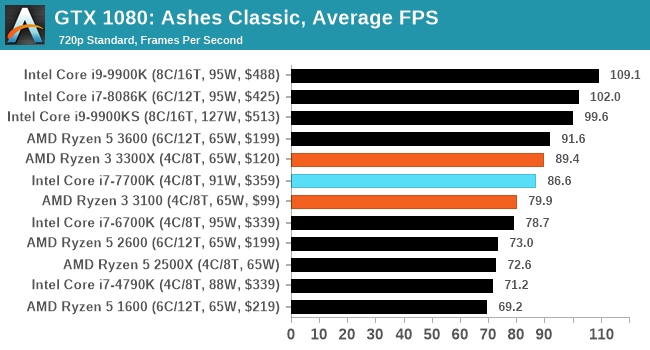 |
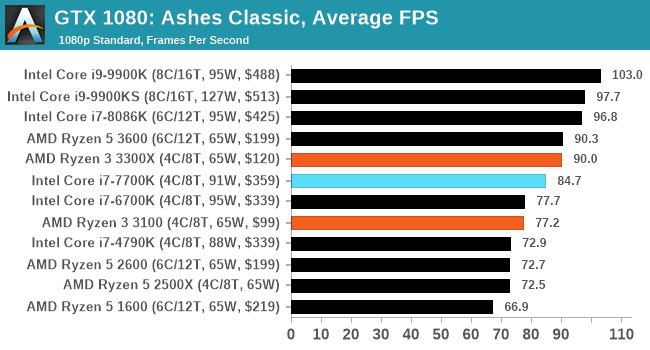 |
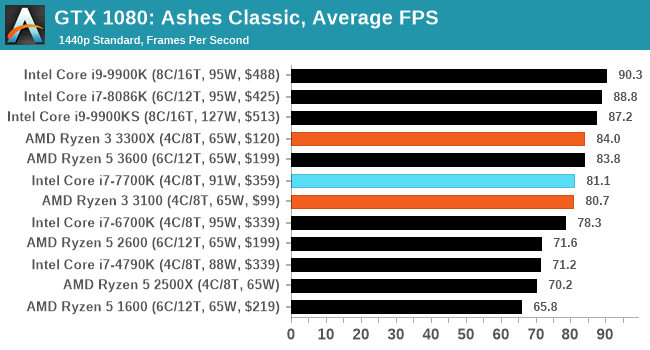 |
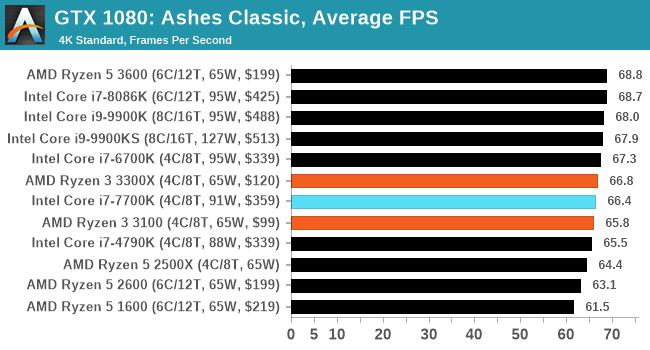 |
| 95th Percentile |  |
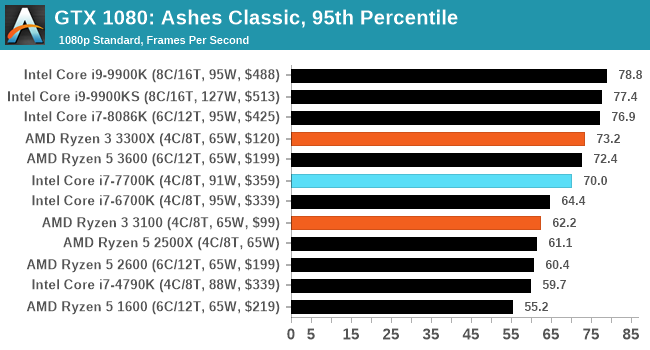 |
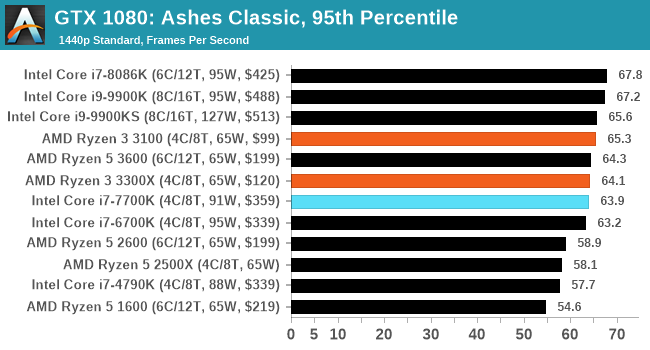 |
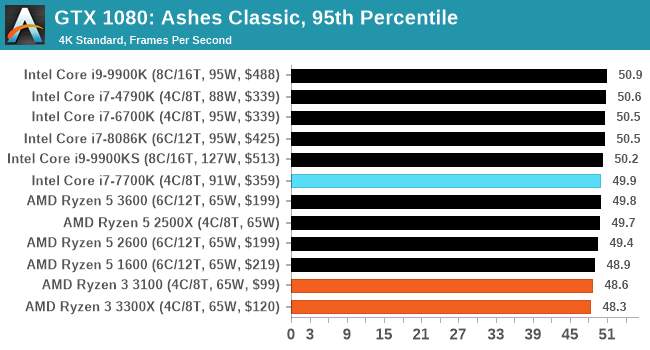 |


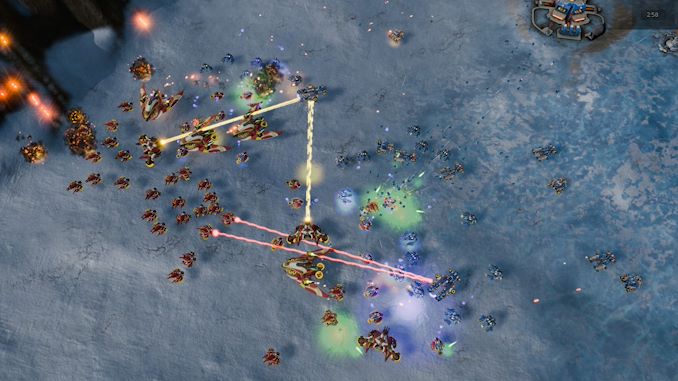









249 Comments
View All Comments
lightningz71 - Friday, May 8, 2020 - link
Because I was typing it on mobile, didn’t proofread before I hit submit, and the spell checker didn’t flag it as being wrong because it doesn’t know context.It’s my fault, my mistake, and I normally strive to do a better job with my spelling in general. Thank you for pointing out my mistake so that I can be more cognizant of my future errors.
Holliday75 - Saturday, May 9, 2020 - link
Now I feel like a d*ck for pointing it out.In all honesty just poking fun and genuinely curious because I see this mistake made daily all over the place. Facebook, comments, even articles by professional journalists and a work email or two. I find it curious when I know the people who speak American English natively and still make this mistake.
Spunjji - Monday, May 11, 2020 - link
Well, Autocorrect is one answer - and the other is the paradoxical relationship between the long "oo" sound in in lose and the shorter "oo" sound in loose. It's hard to argue that the spelling shouldn't be the other way around, although I have no doubt would still trip over it even then.notb - Thursday, May 7, 2020 - link
Idle power draw is atrocious. How can it be this high?It's not even that I'm worried about the unnecessary electricity use or noise (which could make an analogous APU a lot less interesting for HTPC and NAS).
I'm just really shocked by interconnect using 16W when the cores it joins are hardly doing anything.
Does anyone know what is I/O die doing? Is there a 10W ASIC mining bitcoin or what?
eastcoast_pete - Thursday, May 7, 2020 - link
Hush! You're spilling the beans here (:Actually, if AMD had a highly efficient ASIC mining chip with good hash rates, I'd consider buying some. Same goes for Intel.
notb - Friday, May 8, 2020 - link
Actually Intel is a major FPGA maker, so you can get one of those. It's not that hard to find an open-source coin miner (even on GitHub).The comment stand though. I googled a bit and there's no clear explanation for the high idle uncore.
And 8-core mobile Zen2 chips use maybe 3W in idle. It's not like their IF is a lot slower or has less to do.
This makes me wonder if we're even going to see desktop/server 35W chips? Not to mention it would be nice if they offered TDP down of 25W...
Suddenly, I'm a lot less interested in an AMD-powered home server or NAS (and BTW: EPYC embedded lineup is still Zen-only).
kepstin - Friday, May 8, 2020 - link
If they do make desktop 35W chips, they'll probably be based on the integrated APU die. I suspect the increased idle power is due either to off-die IF link to the IO chiplet needing more power than IF within a die, or perhaps the (14nm) IO chiplet itself having higher power usage.notb - Friday, May 8, 2020 - link
I'm OK with this kind of uncore under load (it's how Zen works).And I don't really mind high idle in workstation CPUs. It's an acceptable compromise.
I just assumed that they'll adjust this for low-core CPUs, since these often go into home PCs used casually - spending a lot of time at idle / low. And under a cheap, slim cooler there will be a difference between 5 and 16W.
AMD will have to fix this in the APUs if they want to take on low-power segments (NAS, HTPC, tiny office desktops).
AFAIK Zen2 APUs will use the chiplet layout, not monolithic approach from the mobile offer. Hence, OEMs will probably use mobile chips anyway. DIY customers may have a problem.
Holliday75 - Saturday, May 9, 2020 - link
We've seen updates addressing issues with previous Zen CPU's. Possible it could be a miss on their part of just didn't have the time to tweak it before release.Namisecond - Thursday, May 7, 2020 - link
Thanks for detailing the two new AMD CPUs. Any news on the new desktop APUs though? I'm hearing rumors of up to 8 cores but the GPUs on them will be worse than the previous generation.